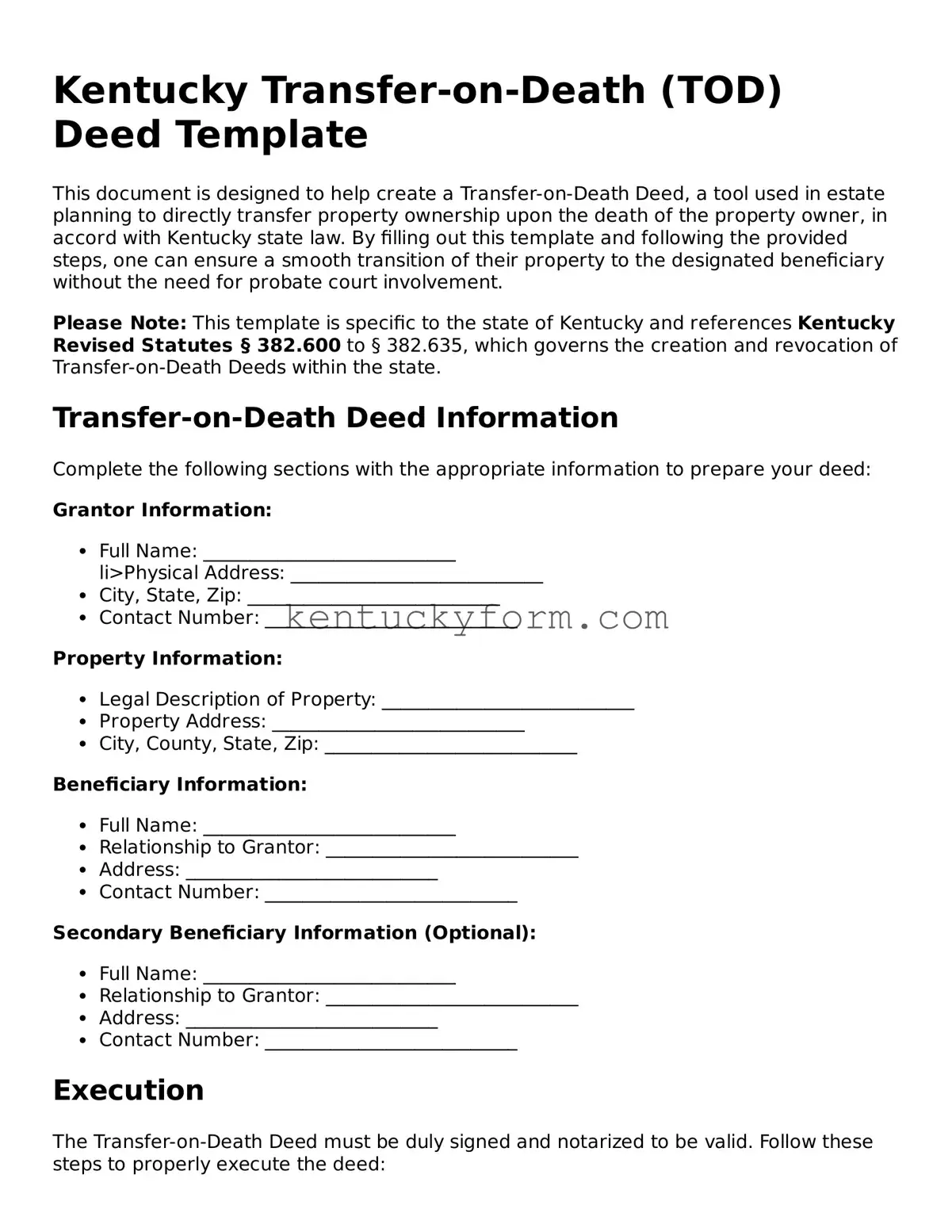The Kentucky Transfer-on-Death Deed form shares similarities with the Last Will and Testament, as both serve to dictate the distribution of a person's assets upon their death. While a Last Will oversees a broad array of assets and requires probate to take effect, the Transfer-on-Death Deed specifically addresses the transfer of real property and bypasses the probate process, directly transferring ownership to the designated beneficiary upon the owner's passing. This direct transfer mechanism simplifies the process, making it a desirable option for real property succession planning.
Similar to a Payable-on-Death (POD) account, the Transfer-on-Death Deed allows for the direct transfer of assets to a named beneficiary, avoiding probate. However, while POD accounts commonly apply to bank accounts and financial assets, the Transfer-on-Death Deed applies exclusively to real property. Both documents enable an individual to maintain control over their assets during their lifetime, with the transfer occurring only upon their death.
The Transfer-on-Death Deed also resembles a Life Estate Deed in the way it handles the future interest in real property. A Life Estate Deed allows an individual to retain use of the property for their lifetime, with the remaining interest passing to a named remainderman upon their death. Unlike the Transfer-on-Death Deed, which conveys the property interest directly upon death without probate, a Life Estate Deed establishes the remainderman's interest upon the creation of the deed, subjecting the property to potential claims and limiting the life tenant's ability to manage it.
Similar in function to a beneficiary designation on retirement accounts or insurance policies, the Transfer-on-Death Deed specifies a beneficiary for real estate, avoiding the probate process. While beneficiary designations pertain to financial assets and insurance proceeds, allowing for direct transfer to the beneficiary upon the account holder's or policy owner’s death, the Transfer-on-Death Deed accomplishes the same for real property, ensuring a streamlined process for transferring ownership.
The Revocable Living Trust is another estate planning tool that shares some features with the Transfer-on-Death Deed. Both allow for the management and transfer of assets upon the owner's death, without going through probate. However, a Revocable Living Trust covers a broader range of assets and provides more control over the terms of distribution, whereas the Transfer-on-Death Deed is specific to real property and does not allow for detailed distribution terms or conditions to be set for the beneficiary.
The Transfer-on-Death Deed has parallels with a Joint Tenancy with Right of Survivorship (JTWROS) agreement, where property is held by two or more parties. Upon the death of one joint tenant, their interest in the property automatically passes to the surviving joint tenant(s), bypassing probate. Unlike JTWROS, which requires all parties to own equal shares and takes effect immediately upon creation, the Transfer-on-Death Deed allows the property owner to retain sole ownership and control until death.
Likewise, the Tenants by the Entirety deed, used by married couples to co-own real estate, ensures that property automatically passes to the surviving spouse without probate upon the death of the other. While similar in its avoidance of probate, the Transfer-on-Death Deed differs in that it does not require the beneficiaries to be married or to hold the property concurrently; it merely designates the beneficiary for the future transfer of the owner's interest in the property.
Lastly, the Gift Deed shares the aspect of transferring property from one person to another but differs significantly in its execution and implications. A Gift Deed transfers property during the owner's lifetime without consideration, and may have tax implications for the giver and receiver. In contrast, the Transfer-on-Death Deed only activates upon death, allowing the owner to maintain full control and use of the property during their lifetime and potentially offering tax benefits associated with estate transfer.
